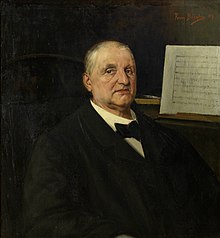布魯克納節奏
外觀

布魯克納節奏是安東·布魯克納的交響樂中的2+3(二連音+三連音)或 3+2節奏,它頻繁[1][2]且以許多不同形式出現。[3]

布魯克納還在他的第二交響曲中使用了重複單個音高的節奏(例如,第20和122小節)。[5]在他的第六交響曲中,布魯克納節奏出現的程度比以前的作品要多得多,在幾個部分出現的時間略有不同。一開始,它作為小提琴音域中高音弦以固定音出現,與大提琴中不同節奏的旋律(第3小節)[6]相對應,而在第 195-209小節,它用於表達六聲音階循環和弦。 [7]這種節奏在第八交響曲的次要主題組中以更「易於處理」的形式出現,通常在所有部分中以相同的方式出現。

布魯克納節奏也出現在其他作曲家的作品中,例如在霍華德漢森的浪漫主義交響曲中,它主要出現在圓號和小號部分。
參考資料[編輯]
- ^ Milton John Cross & David Ewen, Encyclopedia of the Great Composers and Their Music. New York: Doubleday (1962): 158. "The second element is a rhythmic pattern so often employed by the composer that it is known as the "Bruckner rhythm."
- ^ Hans-Hubert Schönzeler. Bruckner. London: Marion Boyars Publishers. 1978: 59.
- ^ John Williamson, "The Brucknerian symphony: an overview", The Cambridge Companion to Bruckner, ed. John Williamson. Cambridge, Cambridge University Press (2004): 79. "Yet even so instantly recognizable a rhythmic tic can be used with great variety."
- ^ Benjamin Korstvedt, "Aspects of Bruckner's approach to symphonic form" The Cambridge Companion to Bruckner, ed. John Williamson. Cambridge, Cambridge University Press (2004): 186.
- ^ Derek Watson, Bruckner. New York: Schuster & Macmillan (1997): 81
- ^ (Williamson, 2004): 79
- ^ Kevin Swinden, "Bruckner and harmony" The Cambridge Companion to Bruckner, ed. John Williamson. Cambridge, Cambridge University Press (2004): 222. "The orchestral texture through this passage is thick, articulating block chords in the 'Bruckner-rhythm' that characterizes the movement, supporting a reprise of the first theme of the symphony."
外部連結[編輯]
- Symphonie no 2 de Bruckner: 國際樂譜典藏計劃上的樂譜
- Time analysis Symphony No. 2 (頁面存檔備份,存於互聯網檔案館), William Carragan
- Symphonie no 4 de Bruckner: 國際樂譜典藏計劃上的樂譜
- Time analysis Symphony No. 4 (頁面存檔備份,存於互聯網檔案館), William Carragan
- Symphonie no 6 de Bruckner: 國際樂譜典藏計劃上的樂譜
- Time analysis Symphony No. 6 (頁面存檔備份,存於互聯網檔案館), William Carragan
- Time analysis Symphony No. 8 (頁面存檔備份,存於互聯網檔案館), William Carragan
